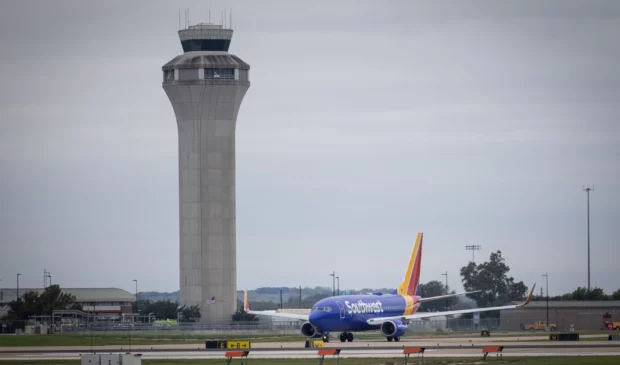Professional weather observers inside the air traffic control tower at Austin-Bergstrom International Airport (ABIA) have no windows or internet access to check the weather radar, satellite imagery or other conditions across the region, according to federal documents.
The weather observers – who play a vital role in the nation’s aviation system by serving as a human backup to automated weather systems – can’t see or hear outside, so they have to walk down two flights of stairs and exit the tower to check the current weather conditions. To look up basic weather data online, they have to go outside and use their iPhones, the documents said.
“To me, as someone in meteorology, that’s just unacceptable,” said Troy Kimmel, a broadcast meteorologist who teaches at UT Austin. “If you go to (other major Texas airports), there’s not another place where weather observers can’t see or have access to tools. There’s not another site like Austin, Texas.”
“It just does not make any sense at all,” Kimmel said.

Michael Minasi/KUT News. Austin-Bergstrom International Airport serves more than 20 million passengers a year.
The city of Austin owns the air traffic control tower and helps maintain the building. But the people who work inside and the technology they use are under the purview of the Federal Aviation Administration.
“There have been no issues with (weather observers) obtaining weather observations at Austin Tower,” FAA spokesperson Tammy L. Jones said in an emailed statement. “Electronic devices, including cell phones, are not permitted in control towers. Internet connectivity is available for all authorized devices in other areas of the buildings.”
But the weather observers contracted by the FAA aren’t federal employees and don’t have access to those “authorized devices,” according to details buried in a trove of documents released by the National Transportation Safety Board. The documents are factual data collected as part of an investigation into a near-miss at ABIA between two large planes on a foggy morning in February 2023.
The NTSB is probing why Austin’s air traffic control cleared a FedEx Boeing 767 to land on the same runway where a Southwest Airlines Boeing 737 was preparing for takeoff. The FedEx plane aborted landing at the last moment, narrowly averting a collision that could have killed 128 passengers and the crew. A final NTSB report is expected soon.

Michael Minasi/KUT News. Pilots can make informed decisions about flight paths, especially in severe weather, with the meteorological reports they receive from the FAA’s contracted weather observers.
Weather observers were not considered a factor in the near-miss. But officials probing the incident interviewed a weather observer manager and asked if a lack of internet access made it harder to do the job.
“Absolutely, yes, sir. Absolutely,” responded John Prator, a veteran weather observer with experience at more than a dozen airports including some of the nation’s largest.
Prator and his employer, California-based Condor Reliability Services, did not respond to requests for comment for this story.
The FAA has already faced criticism for not having enough air traffic controllers in the Austin tower, resulting in mandatory overtime and six-day work weeks.
U.S. Democratic Reps. Lloyd Doggett and Greg Casar of Texas have blasted the agency for controller staffing levels at ABIA, part of a chronic nationwide shortage for which Doggett has demanded “swift and forceful actions.”






